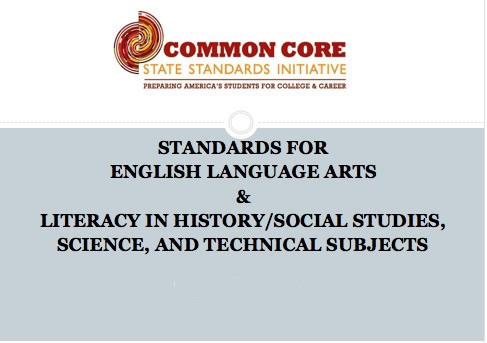English Language Arts
Common Core State Standards adopted in United States of America


Strengths of the ELA Common Core State Standards
- The standards make it clear what students should know and be able to do in reading writing, speaking/listening and language.
- The are sequentially organized to ensure students are ready for college and careers by the time they graduate from high school.
- They incorporate rigorous application of content and knowledge through high-order skills.
- Concepts and skills are taught across the curriculum.
- The strengths and lessons of current state standards as well as internationally benchmarked skills have bee incorporated into the standards so all students are prepared to succeed in the global economy and society.
- The standards are the same in grades K through 12: however, text complexity and specific skills differ at each grade level.
- There are three genres of writing implemented at each grade level. ( Narrative, Informative/Expository and Argument)
- The emphasis is on the depth of comprehension in reading and writing, not on the breadth of the information covered.
- Instruction will be based on thematic content units not on strategies and sub-skills in isolation.
- Students will be assessed through performance tasks, i.c., authentic reading and writing.
- Teachers will use their skills in determining how best to teach their students the concepts.
- Balance literacy will continue to be part of the curriculum in elementary grades, with shared reading, guided reading and writing blocks.
Organization of the ELA Common Core State Standards
There are five major strands in the ELA core. Each of the five strands is defined in greater detail below.
Reading
- The standards establish a “staircase” of increasing complexity in what students must be able to read so that all students are ready for the demands of college- and career-level reading no later than the end of high school. The standards also require the progressive development of reading comprehension so that students advancing through the grades are able to gain more from whatever they read.
- Through reading a diverse array of classic and contemporary literature as well as challenging informational texts in a range of subjects, students are expected to build knowledge, gain insights, explore possibilities, and broaden their perspective. Because the standards are building blocks for successful classrooms, but recognize that teachers, school districts and states need to decide on appropriate curriculum, they intentionally do not offer a reading list. Instead, they offer numerous sample texts to help teachers prepare for the school year and allow parents and students to know what to expect at the beginning of the year.
- The standards mandate certain critical types of content for all students, including classic myths and stories from around the world, foundational U.S. documents, seminal works of American literature, and the writings of Shakespeare. The standards appropriately defer the many remaining decisions about what and how to teach to states, districts, and schools.
Writing
- The ability to write logical arguments based on substantive claims, sound reasoning, and relevant evidence is a cornerstone of the writing standards, with opinion writing—a basic form of argument—extending down into the earliest grades.
- Research—both short, focused projects (such as those commonly required in the workplace) and longer term in depth research —is emphasized throughout the standards but most prominently in the writing strand since a written analysis and presentation of findings is so often critical.
- Annotated samples of student writing accompany the standards and help establish adequate performance levels in writing arguments, informational/explanatory texts, and narratives in the various grades.
Speaking and Listening
- The standards require that students gain, evaluate, and present increasingly complex information, ideas, and evidence through listening and speaking as well as through media.
- An important focus of the speaking and listening standards is academic discussion in one- on-one, small-group, and whole-class settings. Formal presentations are one important way such talk occurs, but so is the more informal discussion that takes place as students collaborate to answer questions, build understanding, and solve problems.
Language
- The standards expect that students will grow their vocabularies through a mix of conversations, direct instruction, and reading. The standards will help students determine word meanings, appreciate the nuances of words, and steadily expand their repertoire of words and phrases.
- The standards help prepare students for real life experience at college and in 21st century careers. The standards recognize that students must be able to use formal English in their writing and speaking but that they must also be able to make informed, skillful choices among the many ways to express themselves through language.
- Vocabulary and conventions are treated in their own strand not because skills in these areas should be handled in isolation but because their use extends across reading, writing, speaking, and listening.
Media and Technology
- Just as media and technology are integrated in school and life in the twenty-first century, skills related to media use (both critical analysis and production of media) are integrated throughout the standards.
